The 1963 Fiat 600, a small car with a big impact, emerged as a symbol of Italian ingenuity and design prowess. Introduced in 1955, the Fiat 600 quickly became a beloved choice for families across Italy and beyond, capturing the hearts of drivers with its affordability, practicality, and charming aesthetics.
This article explores the fascinating history, design, and enduring legacy of this iconic Italian automobile.
The Fiat 600’s story is one of innovation and adaptation. Born from the need for affordable transportation in post-war Italy, the car’s compact size and fuel-efficient engine made it an ideal choice for urban dwellers. Its success was not only due to its practicality but also to its stylish design, which embodied the spirit of Italian design and craftsmanship.
The 600 quickly became a cultural phenomenon, appearing in films, television shows, and even influencing fashion trends.
History and Background: 1963 Fiat 600
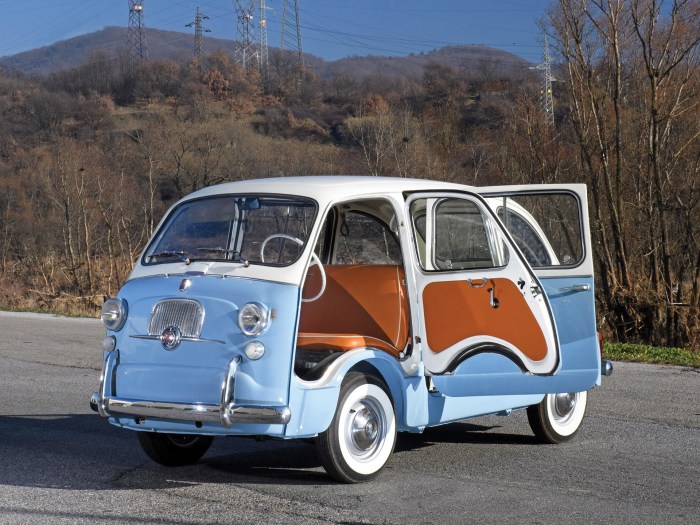
The Fiat 600, a compact city car that became a cultural icon in Italy and beyond, emerged from a time of post-war economic recovery and a growing demand for affordable personal transportation. Its development was a strategic move by Fiat, the Italian automotive giant, to capitalize on this burgeoning market.
The Fiat 600’s significance in the Italian automotive industry cannot be overstated. It played a crucial role in democratizing car ownership in Italy, making personal mobility accessible to a broader segment of the population. Its success was instrumental in shaping the Italian car industry’s focus on compact, fuel-efficient vehicles, a trend that would continue for decades to come.
Design Philosophy and Intended Market
The Fiat 600 was conceived with a clear design philosophy: to create a small, affordable, and practical car that would appeal to a wide range of buyers, from young families to urban commuters. The car’s compact dimensions, combined with its innovative rear-engine layout, made it highly maneuverable and efficient in congested city streets.
The intended market for the Fiat 600 was primarily the growing middle class in Italy and other European countries. Fiat aimed to provide a car that was both economical to operate and stylish enough to be desirable. The car’s success in achieving this goal is evident in its long production run and its enduring popularity.
Development Process
The development of the Fiat 600 was spearheaded by a team of talented engineers and designers led by Dante Giacosa, a renowned figure in the history of Italian automotive design. The car’s development was influenced by several factors, including the need for a compact and efficient design, the use of readily available materials, and the desire to create a car that was both affordable and stylish.
“The Fiat 600 was a car that was designed to be affordable, practical, and fun to drive. It was a car that was meant to be enjoyed by everyone, from young families to urban commuters.”
Dante Giacosa
One of the key innovations in the Fiat 600’s design was its rear-engine layout. This configuration, inspired by the Volkswagen Beetle, offered several advantages, including a spacious interior and a low center of gravity, which improved handling. The Fiat 600’s development process was characterized by a strong focus on cost-effectiveness and simplicity.
The car was designed to be manufactured using readily available materials and components, minimizing production costs. This approach allowed Fiat to offer the car at a price that was accessible to a wide range of buyers.
Design and Features
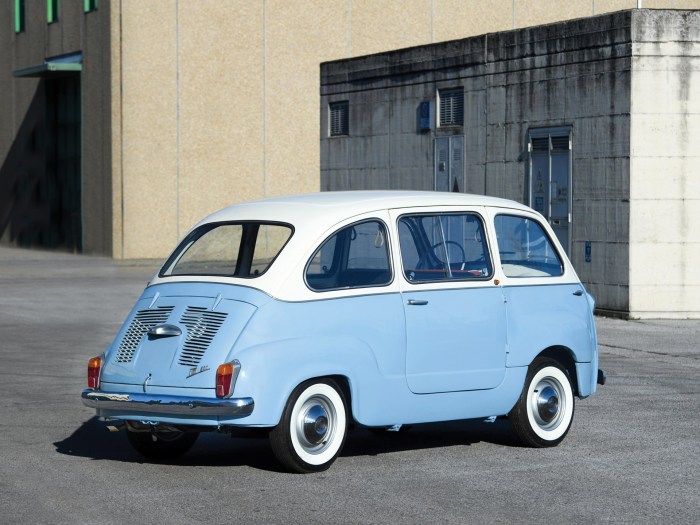
The Fiat 600, despite its small size, was a car that embodied Italian style and practicality. It was designed to be affordable, fuel-efficient, and easy to maneuver in congested urban environments.
Exterior Design
The Fiat 600’s exterior design was characterized by its compact dimensions, rounded curves, and simple lines. Its small size, with a length of just 3.2 meters, made it ideal for navigating narrow streets and tight parking spaces. The car’s distinctive styling features included a large, upright grille with a chrome surround, round headlights, and a gently sloping roofline.
The 1963 Fiat 600, a compact and affordable city car, became a global phenomenon, symbolizing post-war optimism and Italian design. This success led to numerous variations, including the whimsical 1971 Fiat Jolly , a beach-ready version with wicker seats and no doors.
While the Jolly’s unique charm was undeniable, the standard Fiat 600 remained the heart of the model’s enduring legacy, continuing to be produced until 1970.
The rear end featured a wrap-around rear window and a small, integrated rear bumper.
Interior Layout
The Fiat 600’s interior was designed to maximize space and comfort within its compact dimensions. It featured a two-door configuration, with a bench seat that could accommodate four passengers. The interior materials were basic but functional, with vinyl upholstery and a simple dashboard.
The car’s compact size meant that legroom and headroom were limited, particularly in the rear. However, the Fiat 600’s interior was designed to be practical and user-friendly.
Mechanical Specifications
The Fiat 600 was powered by a small, air-cooled, two-cylinder engine that produced around 17 horsepower. This engine was mated to a four-speed manual transmission. The car’s suspension system consisted of independent front suspension and a rigid rear axle. The Fiat 600 was known for its fuel efficiency, with a claimed fuel consumption of around 50 miles per gallon.
Production and Sales
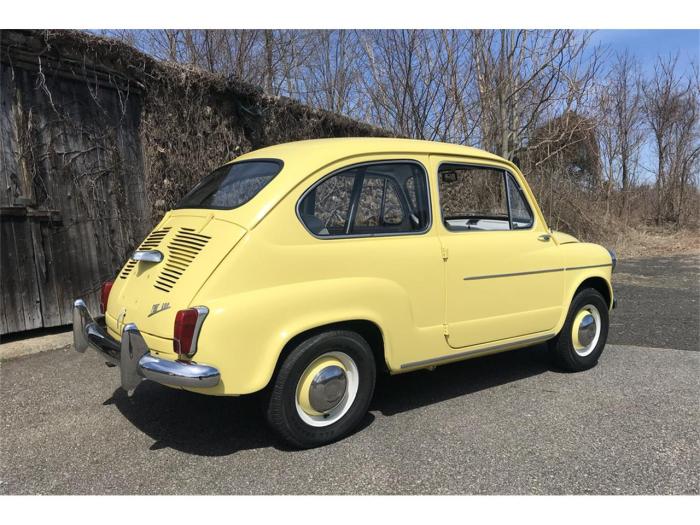
The Fiat 600’s production spanned over two decades, showcasing its enduring popularity and significant impact on Fiat’s sales. Its manufacturing process was innovative for its time, contributing to its affordability and accessibility.
Production Timeline and Units Produced
The Fiat 600’s production began in 1955 and continued until 1970, with a total of 2,695,000 units produced. This figure includes various body styles and versions, highlighting the car’s widespread appeal across different markets.
Popularity in Various Markets
The Fiat 600 gained immense popularity in numerous countries, including Italy, Spain, France, and Germany. Its compact size and fuel efficiency made it an ideal city car, particularly in crowded urban environments. It was also exported to Latin America, Africa, and Asia, further solidifying its global presence.
The car’s affordability and practicality contributed to its widespread adoption, especially among young families and individuals seeking affordable transportation.
Impact on Fiat’s Sales, 1963 Fiat 600
The Fiat 600 was a resounding success for Fiat, significantly boosting the company’s sales and establishing it as a leading manufacturer of small cars. The car’s popularity helped Fiat achieve significant market share in Europe and other regions, contributing to its financial success and solidifying its position as a major player in the automotive industry.
Production Facilities and Manufacturing Processes
The Fiat 600 was primarily manufactured at Fiat’s Mirafiori plant in Turin, Italy. The plant was equipped with advanced production lines and technologies, allowing for efficient and cost-effective production. Fiat implemented innovative manufacturing techniques, such as the use of a unibody construction, which simplified the assembly process and reduced production costs.
This approach contributed to the car’s affordability, making it accessible to a wider audience.
Variations and Models
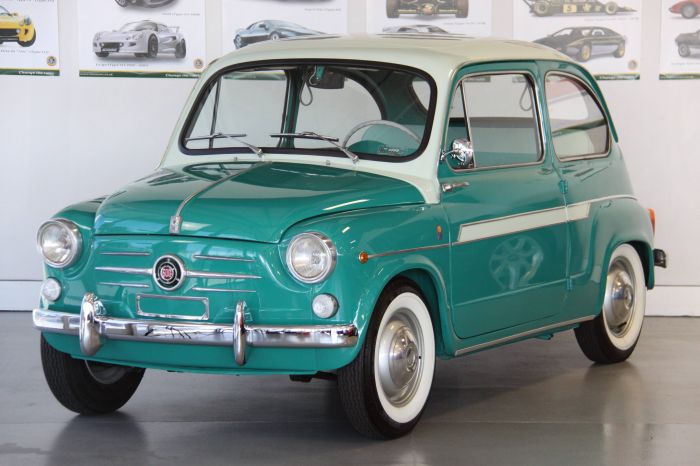
The Fiat 600, a revolutionary car for its time, was produced in various versions and models catering to different needs and preferences. These variations evolved over the years, encompassing changes in engine size, features, and styling, each reflecting the evolving automotive landscape and consumer demands.
Different Versions and Models
The Fiat 600 was available in various body styles and configurations, each offering a unique blend of functionality and aesthetics. The most popular versions included:
- Fiat 600 (1955-1969):The original model, affectionately nicknamed “Seicento,” was a two-door saloon with a compact design and a rear-mounted engine. It was renowned for its affordability, maneuverability, and fuel efficiency, making it a popular choice for urban dwellers and families.
- Fiat 600D (1959-1969):This version introduced a larger engine with a higher power output, improving performance and acceleration. It also featured a more spacious interior, accommodating five passengers comfortably.
- Fiat 600 Multipla (1956-1969):This unique model was a six-seater station wagon with a distinctive, boxy design. It was designed for families and offered ample cargo space, making it ideal for weekend getaways or carrying larger loads.
- Fiat 600 Berlina (1960-1969):A four-door saloon variant, the Berlina offered increased passenger capacity and practicality, making it a more family-oriented option compared to the original two-door model.
- Fiat 600T (1961-1969):The “T” stood for “Turismo,” signifying this model’s focus on performance. It featured a more powerful engine and sporty styling, making it a popular choice for drivers seeking a more engaging driving experience.
- Fiat 600 Jolly (1958-1969):A unique and whimsical version, the Jolly was a stripped-down beach buggy with wicker seats and a removable roof. It was designed for leisure and was often seen in coastal resorts, capturing the spirit of the carefree 1960s.
Engine Size, Features, and Styling
The various Fiat 600 models were distinguished by their engine sizes, features, and styling, reflecting the evolution of the car and the changing preferences of its target audience.
- Engine Size:The Fiat 600 featured a range of engines, starting with a small 633 cc unit in the original model and culminating in a larger 767 cc engine in the 600D and later versions. These engines offered varying levels of power and fuel efficiency, catering to different driving needs and preferences.
- Features:The Fiat 600 evolved over the years, incorporating new features and amenities. Early models were relatively basic, offering essential features like a heater and windshield wipers. Later versions introduced more luxurious features, such as radios, power steering, and even automatic transmissions, depending on the specific model and trim level.
- Styling:The Fiat 600 underwent several stylistic updates throughout its production run. The original model had a simple and functional design, while later versions adopted a more refined and modern aesthetic. These changes included updated front grilles, headlights, and taillights, as well as interior trims and upholstery, contributing to the car’s evolving character.
Special Editions and Limited-Run Models
Fiat 600’s popularity spawned several special editions and limited-run models, each offering unique features and styling elements, making them highly sought-after by collectors and enthusiasts. Some notable examples include:
- Fiat 600 “Cinquant’anni” (1975):This special edition celebrated the 20th anniversary of the Fiat 600. It featured a distinctive two-tone paint scheme, chrome accents, and a commemorative plaque.
- Fiat 600 “Sporting” (1965):This limited-run model featured sportier styling cues, including a black grille, special wheels, and a sporty interior. It was marketed as a more performance-oriented version of the Fiat 600.
- Fiat 600 “Automatix” (1969):This model featured an automatic transmission, a rare option for the Fiat 600. It offered greater convenience and ease of driving, particularly in urban environments.
Cultural Impact
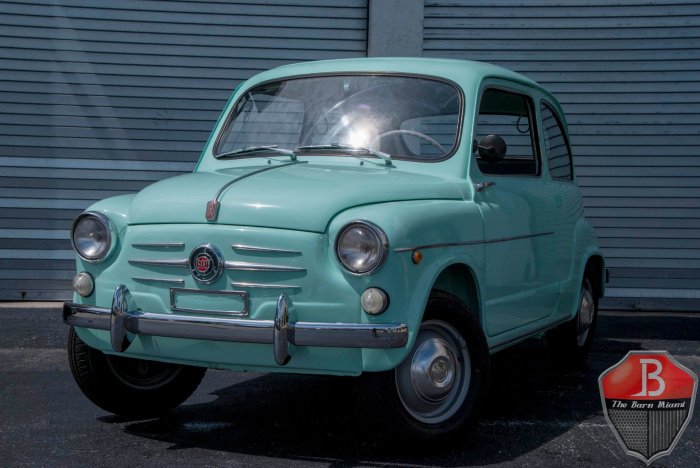
The Fiat 600 transcended its role as a mere mode of transportation, becoming deeply embedded in Italian culture and society. Its compact size, affordability, and practicality resonated with the aspirations of post-war Italy, symbolizing economic recovery, social mobility, and a newfound sense of optimism.
The 1963 Fiat 600, a compact and affordable city car, was a huge success for Fiat, becoming a symbol of postwar economic prosperity in Italy. While the 600 was designed for practicality, Fiat also offered sportier models like the 600 D, showcasing the brand’s versatility.
For a more open-air experience, one could consider the 1956 Fiat Barchetta , a stylish roadster that captured the essence of Italian automotive design. However, the 600 remained a popular choice for its affordability and practicality, becoming a staple on European roads for many years.
Impact on Italian Culture and Society
The Fiat 600 played a pivotal role in shaping Italian culture and society, becoming more than just a car; it was a symbol of a changing nation. The car’s affordability allowed families to own a vehicle for the first time, facilitating weekend getaways and family vacations.
Its compact size made it ideal for navigating crowded city streets, contributing to the growth of urban mobility. The Fiat 600 also became a symbol of Italian design and engineering prowess, showcasing the country’s ability to create innovative and stylish products.
The car’s popularity contributed to the development of a thriving automotive industry in Italy, creating jobs and boosting the economy.
The Fiat 600 in Popular Media
The Fiat 600’s cultural impact extended beyond its presence on Italian roads. The car’s distinctive design and widespread popularity made it a frequent fixture in popular media, appearing in films, television shows, and literature. In cinema, the Fiat 600 served as a backdrop for stories set in Italy, often representing the everyday lives of ordinary people.
For instance, in Federico Fellini’s “La Dolce Vita” (1960), a Fiat 600 is prominently featured, reflecting the changing social dynamics of post-war Italy.
Anecdotes and Stories
The Fiat 600’s impact on everyday life in Italy is evident in countless anecdotes and stories shared by generations of Italians. Many recall their first car being a Fiat 600, fondly remembering the car’s reliability and practicality. The car’s ability to navigate narrow streets and tight parking spaces made it an indispensable companion in urban environments.
For many families, the Fiat 600 was more than just a car; it was a symbol of freedom, adventure, and a shared sense of national pride.
Legacy and Enduring Appeal

The Fiat 600, despite its humble origins and small size, has left an enduring mark on automotive history. It remains a beloved classic, captivating collectors and enthusiasts, and its influence continues to be felt in the design and functionality of modern cars.
The Fiat 600’s Enduring Popularity
The Fiat 600’s enduring popularity can be attributed to several factors. Its compact size and affordability made it an ideal vehicle for a rapidly growing post-war population. The car’s simple design and reliable engine made it easy to maintain and operate, while its stylish and functional interior provided a comfortable driving experience.
Moreover, the Fiat 600’s versatility, with its ability to be adapted for various uses, including commercial applications, contributed to its widespread appeal.
The Fiat 600 as a Classic
The Fiat 600’s status as a classic is solidified by its timeless design and its role in shaping automotive history. Its simple yet elegant lines, with its distinctive rounded body and large, wraparound windshield, continue to be admired today. Collectors and enthusiasts are drawn to the car’s historical significance and its nostalgic appeal, making it a sought-after classic.
The Fiat 600’s Influence on Subsequent Car Models
The Fiat 600’s influence can be seen in subsequent car models, particularly in the development of compact city cars. Its compact size, efficient engine, and versatile design paved the way for a new generation of small, affordable vehicles. The Fiat 500, a modern interpretation of the original 600, continues to be a popular choice for city dwellers and those seeking a stylish and economical car.
Closing Notes

The 1963 Fiat 600’s legacy continues to resonate today. Its enduring popularity speaks to its timeless design and its role in shaping Italian automotive history. The car remains a sought-after collectible, and its influence can be seen in modern-day compact cars.
The 1963 Fiat 600 stands as a testament to the power of innovation, affordability, and style, proving that even a small car can leave a lasting impact on the world.